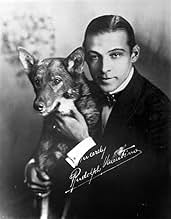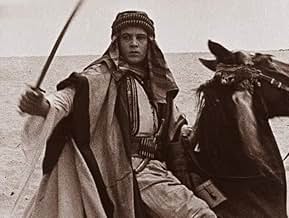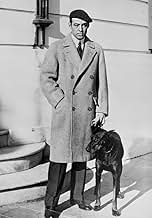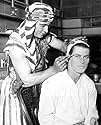PUNTUACIÓN EN IMDb
5,3/10
143
TU PUNTUACIÓN
Añade un argumento en tu idiomaA "dramatization" of the life of actor Rudolph Valentino, widely regarded as the screen's first male sex symbol.A "dramatization" of the life of actor Rudolph Valentino, widely regarded as the screen's first male sex symbol.A "dramatization" of the life of actor Rudolph Valentino, widely regarded as the screen's first male sex symbol.
- Dirección
- Guión
- Reparto principal
Lesley Ann Warren
- Laura Lorraine
- (as Lesley Warren)
Harold J. Stone
- Sam Baldwin
- (as Harold Stone)
Constance Forslund
- Silent Star
- (as Connie Forslund)
Abraham Alvarez
- Policeman
- (as Abe Alvarez)
Reseñas destacadas
... which is what is written under the title in this complete fantasy.
I don't know Valentino's life story like the back of my hand like I know Buster Keaton's, but I know enough to realize that only some of the names are correct, but dates, the order of films, and especially the relationships between the players are all wrong.
Valentino's first role was not "Four Horsemen of the Apocalypse". It was his breakout role, but he'd been in films for seven years prior. In the final scene he's onstage after "Son of the Sheik" has played and says he came to the United States three years before. That would be 1923, which was two years after Four Horsemen, which would be quite a feat. June Mathis, who wrote several of Valentino's best films, did not come from Brooklyn, and did not move there. She continued to write scripts until her death in 1927, just a year after Valentino died. And most importantly, Valentino did not meet Mathis by burglarizing her house one night when he was hungry.
All of this is the work of producer Aaron Spelling, who produced "mind candy" shows for TV like Charlie's Angels throughout the 1970s and into the 1980s. Thus this is par for the course. So he makes Valentino out to be an easily conned rube who is considered gay by all of the women in his life in spite of his reputation.
I will say that the performances were good, whoever it was that the actors were actually portraying.
I don't know Valentino's life story like the back of my hand like I know Buster Keaton's, but I know enough to realize that only some of the names are correct, but dates, the order of films, and especially the relationships between the players are all wrong.
Valentino's first role was not "Four Horsemen of the Apocalypse". It was his breakout role, but he'd been in films for seven years prior. In the final scene he's onstage after "Son of the Sheik" has played and says he came to the United States three years before. That would be 1923, which was two years after Four Horsemen, which would be quite a feat. June Mathis, who wrote several of Valentino's best films, did not come from Brooklyn, and did not move there. She continued to write scripts until her death in 1927, just a year after Valentino died. And most importantly, Valentino did not meet Mathis by burglarizing her house one night when he was hungry.
All of this is the work of producer Aaron Spelling, who produced "mind candy" shows for TV like Charlie's Angels throughout the 1970s and into the 1980s. Thus this is par for the course. So he makes Valentino out to be an easily conned rube who is considered gay by all of the women in his life in spite of his reputation.
I will say that the performances were good, whoever it was that the actors were actually portraying.
I was only vaguely aware of this one, so much so that I added it to the Ken Russell tribute schedule (since he also made a film about Valentino) at the very last minute! Interestingly, Russell's big-screen biopic was released a mere 2 years after this TV-film, just as Karel Reisz's 1968 version of ISADORA came hot on the heels of Russell's own for the small-screen from 2 years previously!
Like those 2 biopics, there are the expected similarities but also major differences between each version: Shavelson's background in scriptwriting serves him in good stead (especially as delivered by Suzanne Pleshette, playing a scriptwriter herself i.e. June Mathis who is credited with giving Valentino his big break). However, here, we are supposed to believe that the actor (played by Franco Nero – a fellow handsome Italian, at least, but who managed to transcend the Latin Lover image fairly early on) became an instant star upon entering the movie industry when he had really languished in the medium for a good 7 years prior to making THE FOUR HORSEMEN OF THE APOCALYPSE (1921): with this in mind, his lead role in the film is described as small but significant(!) and, what is more, since he is caught by Pleshette – who immediately notices his magnetic qualities and iconic possibilities – burgling her house (his very first line of dialogue, in fact, is the Italian cussword "stronza"!), she fakes an aristocratic background for him on the spot!
As with the Russell version, the script plays around with the chronology of events (1925's THE EAGLE – incongruously shown in a montage via snippets of the genuine Valentino footage – comes before BLOOD AND SAND, made a full 3 years prior to it!). Incidentally, judging by the titles that are mentioned, one would think that the star made nothing but exotic costumers, when this is clearly not the case and that he knew beforehand just what properties would suit him (since no sooner is HORSEMEN released that he is already discussing the acquisition of CAMILLE, actually as Alla Nazimova's leading man – his future wife Natacha Rambova had been a close collaborator of hers and possibly even lover, BLOOD AND SAND and MONSIEUR BEAUCAIRE!). While Rambova is shown being superstitiously influenced by runes in the Ken Russell picture, here she persuades Valentino to attend a séance in order to communicate with his mother (who passed away during the shooting of CAMILLE, as per this version and while he was still on HORSEMEN according to Russell's)!
While he is also shown being involved with his leading ladies, this one commits the cardinal sin of making Rambova (as played by a dark-haired Yvette Mimieux) a total bore and utterly unsympathetic to boot – while Michelle Philips from the later film may not have looked anything like the genuine article (but, then, neither did Rudolf Nureyev), her striking looks at least make us accept his dependence on her! Indeed, as already intimated, Pleshette comes across much better (with the film's best scene – which does not appear in Russell's biopic and is probably a complete fabrication – being the one towards the end when Nero presents Pleshette's Mathis as the real force behind the Valentino image). Despite the fact that some of Valentino's directors appear here (notably Rex Ingram), they are not played by recognizable faces as in Russell's film, but we do get Milton Berle as Paramount head Jesse L. Lasky and Judd Hirsch in more or less the part played by Seymour Cassel in 1977. Besides while the actor's effeminacy ("finocchio") is brought up, oddly enough, the boxing match held in order to uphold his manliness is omitted – as is, for that matter, the 2-year sabbatical he took from movie-making after the failure of the expensive THE YOUNG RAJAH (1922; which, regrettably, is currently unavailable for appraisal)!
Like those 2 biopics, there are the expected similarities but also major differences between each version: Shavelson's background in scriptwriting serves him in good stead (especially as delivered by Suzanne Pleshette, playing a scriptwriter herself i.e. June Mathis who is credited with giving Valentino his big break). However, here, we are supposed to believe that the actor (played by Franco Nero – a fellow handsome Italian, at least, but who managed to transcend the Latin Lover image fairly early on) became an instant star upon entering the movie industry when he had really languished in the medium for a good 7 years prior to making THE FOUR HORSEMEN OF THE APOCALYPSE (1921): with this in mind, his lead role in the film is described as small but significant(!) and, what is more, since he is caught by Pleshette – who immediately notices his magnetic qualities and iconic possibilities – burgling her house (his very first line of dialogue, in fact, is the Italian cussword "stronza"!), she fakes an aristocratic background for him on the spot!
As with the Russell version, the script plays around with the chronology of events (1925's THE EAGLE – incongruously shown in a montage via snippets of the genuine Valentino footage – comes before BLOOD AND SAND, made a full 3 years prior to it!). Incidentally, judging by the titles that are mentioned, one would think that the star made nothing but exotic costumers, when this is clearly not the case and that he knew beforehand just what properties would suit him (since no sooner is HORSEMEN released that he is already discussing the acquisition of CAMILLE, actually as Alla Nazimova's leading man – his future wife Natacha Rambova had been a close collaborator of hers and possibly even lover, BLOOD AND SAND and MONSIEUR BEAUCAIRE!). While Rambova is shown being superstitiously influenced by runes in the Ken Russell picture, here she persuades Valentino to attend a séance in order to communicate with his mother (who passed away during the shooting of CAMILLE, as per this version and while he was still on HORSEMEN according to Russell's)!
While he is also shown being involved with his leading ladies, this one commits the cardinal sin of making Rambova (as played by a dark-haired Yvette Mimieux) a total bore and utterly unsympathetic to boot – while Michelle Philips from the later film may not have looked anything like the genuine article (but, then, neither did Rudolf Nureyev), her striking looks at least make us accept his dependence on her! Indeed, as already intimated, Pleshette comes across much better (with the film's best scene – which does not appear in Russell's biopic and is probably a complete fabrication – being the one towards the end when Nero presents Pleshette's Mathis as the real force behind the Valentino image). Despite the fact that some of Valentino's directors appear here (notably Rex Ingram), they are not played by recognizable faces as in Russell's film, but we do get Milton Berle as Paramount head Jesse L. Lasky and Judd Hirsch in more or less the part played by Seymour Cassel in 1977. Besides while the actor's effeminacy ("finocchio") is brought up, oddly enough, the boxing match held in order to uphold his manliness is omitted – as is, for that matter, the 2-year sabbatical he took from movie-making after the failure of the expensive THE YOUNG RAJAH (1922; which, regrettably, is currently unavailable for appraisal)!
I have to laugh at the overwrought reviewers here who are sooo upset and bothered by this harmless but watchable movie. You take it so seriously and whine about it not being an accurate portrayal of Valentino and his life. Maybe developing a sense of humor and taking a laxative might help.
If you knew anything about Valentino's life, you'd know that this isn't as inaccurate as you claim. (And even IF it were as bad as you state, it's a TV movie from the 70s so what did you expect?) It's still much better than Ken Russell's version, plus it's always a pleasure to watch Franco Nero in anything. He has the look and the (natural) accent and I think he does a good job as Valentino. Even though the movie has some factual events and characters in it, it's referred to as "a romantic fiction" for a reason, so calm down, take your laxative, and try to enjoy it for what it is. Also, try reading a book about Valentino -- there are many out there -- and maybe then you'll eat your anguished words and learn just how factual a good portion of this movie really is. Besides, how many biopics do you think there are that are completely factual? Very few.
If you knew anything about Valentino's life, you'd know that this isn't as inaccurate as you claim. (And even IF it were as bad as you state, it's a TV movie from the 70s so what did you expect?) It's still much better than Ken Russell's version, plus it's always a pleasure to watch Franco Nero in anything. He has the look and the (natural) accent and I think he does a good job as Valentino. Even though the movie has some factual events and characters in it, it's referred to as "a romantic fiction" for a reason, so calm down, take your laxative, and try to enjoy it for what it is. Also, try reading a book about Valentino -- there are many out there -- and maybe then you'll eat your anguished words and learn just how factual a good portion of this movie really is. Besides, how many biopics do you think there are that are completely factual? Very few.
¿Sabías que...?
- CuriosidadesThe first American made for television movie to star Franco Nero.
- PifiasAlthough at the end of the film, Valentino says he's been in America for three years, he actually was in America for over ten years and had been a star for half that time.
- ConexionesReferences Los cuatro jinetes del apocalipsis (1921)
Selecciones populares
Inicia sesión para calificar y añadir a tu lista para recibir recomendaciones personalizadas
Detalles
- Fecha de lanzamiento
- País de origen
- Idioma
- Títulos en diferentes países
- The Legend of Valentino
- Localizaciones del rodaje
- Empresa productora
- Ver más compañías en los créditos en IMDbPro
Contribuir a esta página
Sugerir un cambio o añadir el contenido que falta

Principal laguna de datos
By what name was La leyenda de Valentino (1975) officially released in Canada in English?
Responde






























